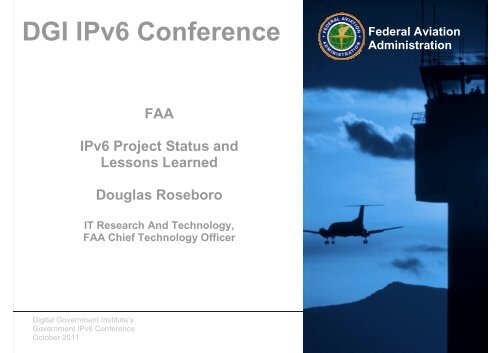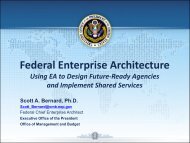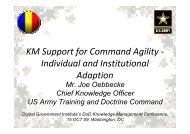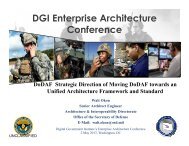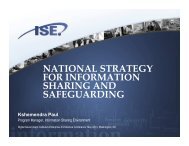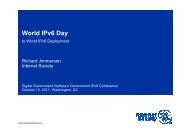Douglas Roseboro, Director Office of IT Research and Development ...
Douglas Roseboro, Director Office of IT Research and Development ...
Douglas Roseboro, Director Office of IT Research and Development ...
- No tags were found...
Create successful ePaper yourself
Turn your PDF publications into a flip-book with our unique Google optimized e-Paper software.
DGI IPv6 ConferenceFederal AviationAdministrationFAAIPv6 Project Status <strong>and</strong>Lessons Learned<strong>Douglas</strong> <strong>Roseboro</strong><strong>IT</strong> <strong>Research</strong> And Technology,FAA Chief Technology <strong>Office</strong>rDigital Government Institute’sGovernment IPv6 ConferenceOctober 2011
Topics• OMB M<strong>and</strong>ate• Background on IPv6 Requirements• IPv6 Strategy <strong>and</strong> Plan• FAA Status• Lessons Learned
• OMBBackground - Federal IPv6 Transition Activities– Issued a Memor<strong>and</strong>um M-05-22, August 2, 2005, which• Required Agencies to demonstrate IPv6 capabilities over the Agencies’ backbonenetwork by June 30, 2008 <strong>and</strong>• Directed NIST to develop IPv6 st<strong>and</strong>ards• FAA successfully met OMB deadline– Issued a Memor<strong>and</strong>um on Requirements for EnterpriseArchitecture <strong>and</strong> IPv6 Progress Reports on November 21, 2007,<strong>and</strong>– Issued a Memor<strong>and</strong>um, dated September 28 2010, describingspecific steps for agencies to expedite the IPv6 deployment
OMB Memo on IPv6 Transition (09/28/2010)• Required Federal Agencies to transition to IPv6 in order to– Enable the successful deployment <strong>and</strong> expansion <strong>of</strong> key Federal informationtechnology (<strong>IT</strong>) modernization initiatives, such as Cloud Computing, Broadb<strong>and</strong>, <strong>and</strong>SmartGrid, which rely on robust, scalable Internet networks;– Reduce complexity <strong>and</strong> increase transparency <strong>of</strong> Internet services by eliminating thearchitectural need to rely on Network Address Translation (NAT) technologies;– Enable ubiquitous security services for end-to-end network communications that willserve as the foundation for securing future Federal <strong>IT</strong> systems; <strong>and</strong>,– Enable the Internet to continue to operate efficiently through an integrated, wellarchitectednetworking platform <strong>and</strong> accommodate the future expansion <strong>of</strong> Internetbasedservices.
Required DOT <strong>and</strong> FAA Actions <strong>and</strong> Timelines• Program Management– Designate an IPv6 Transition Manager <strong>and</strong> submitting their name, title, <strong>and</strong> contactinformation to IPv6@omb.eop.gov by October 30, 2010– Plan to meet with Federal IPv6 Task Force on the week December 6 th <strong>and</strong> follow onTechStat sessions in the future to ensure a timely <strong>and</strong> successful transition to IPv6– Review procurement guideline to ensure procurements <strong>of</strong> networked <strong>IT</strong> comply withFAR requirements for use <strong>of</strong> the USGv6 Pr<strong>of</strong>ile <strong>and</strong> Test Program for thecompleteness <strong>and</strong> quality <strong>of</strong> their IPv6 capabilities• Technology Implementation– Upgrade public/external facing servers <strong>and</strong> services (e.g. web, email, DNS, ISPservices, etc) to operationally use native IPv6 by the end <strong>of</strong> FY 2012– Upgrade internal client applications that communicate with public Internet servers <strong>and</strong>supporting enterprise networks to operationally use native IPv6 by the end <strong>of</strong> FY 2014
IPv6 Benefits• Operationso Increased dem<strong>and</strong> for connectivity from remote & international partners(NextGen program)oImproved connectivity for FAA mobile workforce (safety inspectors, accidentinvestigators etc)• Technicalo Significantly increase the available address spaceoProvides options to improve network architecture <strong>and</strong> efficiency Network design no longer restricted by the number <strong>of</strong> available addressesoImproves end-to-end security <strong>and</strong> communications Better access control through NAT <strong>and</strong> application proxies Built-in IPSEC at network layer (instead <strong>of</strong> at the application layer) Makes network scanning attacks nearly impossibleoSimplifies application development <strong>and</strong> deployment No work around because <strong>of</strong> NAT is needed6
OverviewWAN Topology7
IPv6 Transition Plan• Collect As-Is– List <strong>of</strong> external facing servers/services (validate)– Impacted physical servers, networks, <strong>and</strong> security devices• Transition to To-Be (Goals <strong>and</strong> Objectives)– Target network configuration– Initial IPv6 address allocations– Security configuration– Server network configuration
IPv6 Transition Plan (continued)• Identify the Issues (Areas <strong>of</strong> Concern)– Hardware upgrade/replacement requirements– S<strong>of</strong>tware upgrade/replacement requirements– Security tools upgrade/replacement requirements– Training requirements– Testing/assessment capabilities– Funding <strong>and</strong> resource availability• Develop a Sequencing Plan ( MS Project)– Early implementation opportunities <strong>and</strong> schedule– Delivery schedule for all identified servers
IPv6 Transition Plan (continued)b. Roles <strong>and</strong> Responsibilities• ARD coordinates requirements <strong>and</strong> compliance reporting activities• LOBs provide dedicated members to Tiger Team• Tiger Team members plan <strong>and</strong> accomplish LOB/SOs implementations• Tiger Team works <strong>and</strong> resolves implementation issues• Identify training requirements <strong>and</strong> training resourcesc. Acquisition• USGv6 Pr<strong>of</strong>ile <strong>and</strong> Test Program designated as core requirements for all networked<strong>IT</strong> purchases when possible - AIO Memo on USGv6 guidanced. Communications <strong>and</strong> Training• Participate in Federal IPv6 Task Force meetings <strong>and</strong> provide OMB/DOTrequirements <strong>and</strong> guidance to Tiger Team <strong>and</strong> LOBs• Chair FAA IPv6 Tiger Team meetings• Status reporting (progress <strong>and</strong> Tech Stat)
FAA IPv6 Transition Plan AccomplishmentsFAA collaboration with web content hosting provider, <strong>and</strong> began testing transition <strong>of</strong>IPv4 to IPv6 web sites• FAA has alternative approach for web content hosting to deliver (1) IPv6 onlyconfiguration <strong>and</strong> (2) dual stack (if hardwired IPv4 address)• FAA IPv6 Working Group re-established, all impacted internal organizations toparticipate•IPv6 Tiger Team tasked to implement deployment•Focused efforts on IPv6 external facing services migration•FAA completed IPv6 address allocation plan•FAA revised policy requiring IPv6 capabilities for future <strong>IT</strong> networks•USGv6 Test Program provides new guidance12
Current Status - FAA IPv6 Transition• IPv6 Tiger Team establishedooooRegularly scheduled meetings hosted by ARD-200Tiger team members from each LOB are responsible for the IPv6implementation <strong>and</strong> progress reporting to the ARD-200High level milestones <strong>and</strong> target dates have been established forimplementation <strong>of</strong> FY2012 requirementsDetailed planning within each LOB is underway• Acquisition policy memo to require IPv6 capabilities based on USGv6pr<strong>of</strong>ile <strong>and</strong> USGv6 Test program for all future networked <strong>IT</strong> purchases hasbeen signed by the FAA CIO <strong>and</strong> distributed• Networks/ Servers/ Services with IPv6 capabilities will be introduced intothe FAA environment in the near future• Security guidance <strong>and</strong> tools upgrade are needed for the new environment• Training classes held for IPv6 WG <strong>and</strong> Tiger Team members13
Lessons Learned• IPv6 deployment is a significant undertakingo Extensive planning <strong>and</strong> coordination is key to kick start implementation (policyochange, awareness, inventory, conduct study, resource, buy-in, training)Significant impact on all current <strong>and</strong> future devices/networks <strong>and</strong> applications• Vendor s<strong>of</strong>tware / hardware products continue to evolve with IPv6capabilitiesooContinue certification process <strong>and</strong> testing <strong>of</strong> productsRelearning <strong>and</strong> retesting may be necessary• Security is an ongoing efforto Security principles stay the same, but policies may need to be revised to adoptooIPv6 features (Policies on tunneling in the internal network)Include security community in IPv6 planning stage <strong>and</strong> training programs (C&Aguidance, penetration tests preparation)Acquire knowledge to install/configure/manage firewalls, to configureIDSs/IPSs <strong>and</strong> monitoring/controlling IPv6 <strong>and</strong> tunneled traffic14
Lessons Learned(Continued)• H<strong>and</strong>s-on is training necessaryo Include Network & System administrators, help desk support, networkooapplication developers, technology buyersThe operational workforce has limited time to devote to trainingAlternate solutions for h<strong>and</strong>s-on training (such as exp<strong>and</strong>ing use <strong>of</strong> webinars)can be effective• Extensive testing is both necessary <strong>and</strong> beneficialo Unit testing may not be as essential if the products have been successfullyootested through the USGv6 associated labs, e.g. UNH-IOL, ICSAIntegration tests, on the other h<strong>and</strong>, are crucial to ensure secure <strong>and</strong>successful deploymentTesting provides h<strong>and</strong>s-on training for gaining IPv6 experiences15
Lessons Learned(Continued)Trusted Internet Connection (TIC) impact• Better manage use <strong>of</strong> Internet access points• TIC strategy to <strong>of</strong>fload heavy internet traffic thru web hosting• Reduced cost ISP cost• Reduces FAA cyber security risks (DDOS)• Front line for routing IPv4/IPv6 traffic• Worldwide site redundancy promotes continuity <strong>of</strong> FAA services16
Lessons Learned(Continued)• Unfunded m<strong>and</strong>ate <strong>and</strong> shrinking agency budget makes IPv6migration task challengingoExecutive support is necessary to drive a successful transitionoAcquisition policy change necessary for procuring IPv6 products17
IPv6 TransitionFederal AviationAdministrationQuestions?
IPv6 TransitionFederal AviationAdministrationBack UpIPv6 Use Case ExperiencesOctober 2011
References• Guidelines for the Secure Deployment <strong>of</strong> IPv6, NIST, SP800-119, December 2010• Router Security Configuration Guide Supplement – Securityfor IPv6 Routers, NSA, May 2006• Guidelines on Firewalls <strong>and</strong> Firewall Policies, NIST, SP800-41,September 2009October 201120


